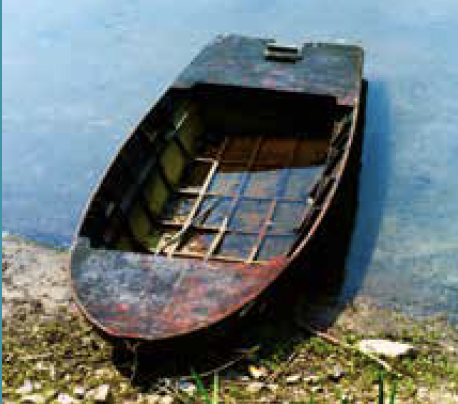A complementary approach for FSHD therapeutics
by Justin Cohen, New Haven, Connecticut
This is an exciting time for facioscapulohumeral muscular dystrophy (FSHD) patients, with many therapeutics entering clinical trials. Most of these focus on targeting DUX4, the toxic protein that causes the disease. However, other approaches are also entering the clinic, including muscle regeneration to help regrow wasted muscle – something particularly useful for more severely affected patients.
 Visualize FSHD muscle as a wooden boat, and DUX4 as a hole with water coming in. For some patients, DUX4- specific therapies plug the hole, and that is all that will be needed because the wood is still sound. However, some may have significant water damage that “rots” the wood. This is where therapeutics for muscle regeneration come in, providing new wood in the rotted areas.
Visualize FSHD muscle as a wooden boat, and DUX4 as a hole with water coming in. For some patients, DUX4- specific therapies plug the hole, and that is all that will be needed because the wood is still sound. However, some may have significant water damage that “rots” the wood. This is where therapeutics for muscle regeneration come in, providing new wood in the rotted areas.
The major tool to accomplish this is stem cells – special cells that have the potential to become any cell in the body. However, stem cells in adults are difficult to grow and limited in what they can become. To overcome these obstacles, many studies use induced pluripotent stem cells (iPSCs), which are fully differentiated adult cells that have been reprogrammed to behave like fetal stem cells, with the potential to become any type of cell in the body.
Initial approaches in FSHD involved generating iPSCs from a patient’s own cells to avoid immune rejection, correcting the mutation, and transplanting the cells back into the patient’s body. However, this is costly and unscalable. Researchers are now focusing on generating healthy cells from a single donor with immune-evading modifications that can be banked and given to all patients.
While several labs including the Perlingeiro group at the University of Minnesota are studying this, Vita Therapeutics has recently announced plans to conduct a trial using this method in FSHD patients in approximately two years if this approach continues to be viable.
Other innovative studies on regeneration are also in development. The Badylak group at the University of Pittsburgh examines the extracellular matrix (ECM), a mixture of compounds that provide structural and biochemical support to cells, including stem cells. First demonstrated to restore some muscle lost to soldiers with war wounds, preliminary ECM studies in FSHD mice showed promising improvement in muscle function. The group is now following up by adding matrixbound nanovesicles (MBV), signaling molecules that can “enhance” the impact of ECM, potentially through immune modulation.
Lastly, FSHD Canada Foundation, together with the SMA Foundation and Myologica, LLC, is pursuing an intriguing collaboration. In this “kitchen sink” approach, various potential muscle regeneration compounds being screened for spinal muscular atrophy are also being tested in FSHD. Most of these compounds enhance stem cells and are already being used in other diseases, which would reduce clinical trial time. One such compound, developed by Satellos Biosciences, Inc., increased muscle force in FSHD and Duchenne muscular dystrophy (DMD) mouse models. A clinical trial in DMD will begin this year.
Overall, there is intriguing progress on muscle regeneration, which has the potential to help the more severely affected FSHD patients. While not a cure, muscle regeneration holds promise and, in the future, may be combined with DUX4-targeting therapies to maximize benefits.


So trials start in 2 years, then something like10+ years for trials. So maybe best case late 2030s. Hardly anything to get excited about.
Well, as I like to say, “it’s better than a kick in the head”. But I know what you mean. I guess we take the disease blockers to preserve strength until the “muscle builders” are around.
Make it faster people have waited to long already.
Gives me enough hope to keep going.
La IA nos ahorrara mucho tiempo y costo.Suerte y gracias